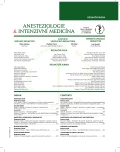CPR-related injuries in out-of-hospital cardiac arrest patients
Authors:
P. Mokrejš 1,2; J. Lejsek 1; E. Tauchmanová 1; J. Moravec 2; R. Zazula 2
Authors‘ workplace:
Zdravotnická záchranná služba Libereckého kraje, p. o, Liberec
1; Anesteziologicko-resuscitační klinika, 1. lékařská fakulta Univerzity Karlovy a Thomayerovy nemocnice v Praze
2
Published in:
Anest. intenziv. Med., 27, 2016, č. 5, s. 315-319
Category:
Overview
Objective:
Quantification of the incidence of CPR-related injuries in unsuccessfully resuscitated out-of-hospital cardiac arrest patients.
Design:
Retrospective observational study.
Setting:
Regional emergency medical services.
Materials and methods:
The study included the autopsy protocols of all 107 patients unsuccessfully resuscitated following non-traumatic out-of-hospital cardiac arrest in the year 2015. We identified all the patients with CPR-related trauma. These patients’ medical reports from the emergency information system were then analysed. They were compared to all the 394 resuscitations performed in the region in 2015.
Results:
CPR-associated major trauma of the chest and upper abdomen was found in 61 autopsy protocols (57% incidence in the deceased group; theoretically at least 15.5% incidence in all the resuscitations). This is most likely to be caused by chest compressions. Twenty three (37 %) of the resuscitations with post-CPR trauma were conducted by the rescue services only and 37 (60.7 %) of the resuscitated patients with post-CPR trauma were younger than 70 years, therefore not all the post-CPR trauma can be ascribed to CPR by lay-persons or the frailty of the patients.
Conclusion:
Further education of the general public in BLS and the adjustment of compressions to the body constitution of the particular patient need to be emphasized in the education of healthcare specialists, especially paramedics and EMS physicians. Further research of post-CPR trauma is necessary.
KEYWORDS:
out of hospital cardiac arrest – resuscitation – trauma – autopsy documents – emergency medical services
Sources
1. Perkins, G. D., Handley, A. J., Koster, K. W. et al. European Resuscitation Council Guidelines for Resuscitation 2015 Section 2. Adult basic life support and automated external defibrillation. Resuscitation, 2015, 95, pp. 81–98.
2. Hoke, R. S., Chamberlain, D. Skeletal chest injuries secondary to cardiopulmonary resuscitation. Resuscitation, 2004, 63, pp. 327–338.
3. Rudinská, L. I., Hejna, P. et. al. Intra-thoracic injuries associated with cardiopulmonary resuscitation – Frequent and serious. Resuscitation, 2016, 103, pp. 66–70.
4. Charakteristika kraje. Český statistický úřad: Krajská správa ČSÚ v Liberci [online]. Liberec, 2016 [cit. 2016-05-18]. Dostupné na: https://www.czso.cz/csu/xl/charakteristika_kraje.
5. Interní databáze Zdravotnické záchranné služby Libereckého kraje, p. o.
6. Miller, A. C., Rosati, S. F., Suffredini, A. F., Schrump, D. S. A systematic review and pooled analysis of CPR-associated cardiovascular and thoracic injuries. Resuscitation, 2014, 85, pp. 724–731.
7. Nikolaou, N. I., Arntz, H. R., Bellou, A., Beygui, F., Bossaert, L. L., Cariou, A. European Resuscitation Council Guidelines for Resuscitation 2015 Section 8. Initial management of acute coronary syndromes. Resuscitation, 2015, 95, pp. 263–276.
8. Soar, J., Nolan, J. P., Bottiger, B. W. et al. European Resuscitation Council Guidelines for Resuscitation 2015 Section 3. Adult advanced life support. Resuscitation, 2015, 95, p. 99–146.
9. Rotondo, M. F., Fildes, J., Bbrasel, K. J. et al. Advanced Trauma Life Support: student course manual. 9. vyd., Chicago, IL American College of Surgeons, 2012, pp. 4–6. ISBN 978-1-880696-02-6.
10. Greif, R., Lockey, A. S., Conaghan, P., Lippert, A., De Vries, W., Monsieurs, K. G. European Resuscitation Council Guidelines for Resuscitation 2015 Section 10. Principles of education in resuscitation. Resuscitation, 2015, 95, p. 287–300.
Labels
Anaesthesiology, Resuscitation and Inten Intensive Care MedicineArticle was published in
Anaesthesiology and Intensive Care Medicine

2016 Issue 5
Most read in this issue
- Hypotension following induction to general anaesthesia: prevalence, significance, risk factors and preventive management options
- The 2016 definition of sepsis (Sepsis-3)
- Selected aspects of anaesthesia for non-obstetric surgical procedures in the pregnant patient
- Body temperature in the anaesthetised child
